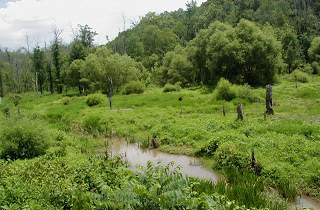What is that mucky dark wooded depression at the bottom of slopes at the edge of the road? What is that long stretch of grasses that reach out to the river? What is that scraggly looking area with the short trees and crooked shrubs? They are all wetlands; forested, emergent and scrub-shrub and they all benefit our human environment. But, they don’t look so pretty. The aesthetics of the swamp, marsh, and bog are in the eye of the beholder.
All of these areas have functions and values including habitat for aquatic and terrestrial species such as birds, snakes, frogs, beavers and deer; food chain production; nutrient removal; groundwater recharge/discharge; water filtration; flood water storage; erosion control; and they provide recreational and educational opportunities for us.
Not all areas that appear wet are wetlands. A wetland is identified by water loving plants; soil that is soaked in water; and water that is around long enough to influence the soil and vegetation. There is a huge field of study that focuses on wetlands. There are wetland and wildlife biologists, soil scientists, ecologists, and botanists who all play a role in identifying wetlands; learning about wetlands; educating the public; and managing these areas to ensure their special functions and values continue to sustain our environment.
What does it mean to us? Wetlands are an important part of the diverse land and water forms that make up the earth. Wetlands represent the base of our food chain. The creatures that make up our seafood rely on these areas for the earliest stages of life. Wetlands filter pollutants that can impact the juvenile and adult species of fish¸ shrimp, crabs and oysters that make up our Sunday dinners and summer cookouts. Wetlands also hold onto storm waters and release them slowly so that heavy rains do not destroy the land with fast flows of high waters. The wetlands along rivers, bays and oceans act as buffers between tides and higher elevation land. The plants in these areas break up wave energy; slow water flow; and keeps the water from reaching banks that would wash away upon direct contact with fast moving waters.
Wetlands are an experience. There is nothing like standing on the edge of a huge tidal wetland. You can smell the salty sea and watch the ducks and osprey hunt for food. The sounds of the waves and wind are calming. The various plants and sandy beaches make up an art scape that no human can replicate. The forested and scrub-shrub wetlands are fun to tromp around. You can jump over small streams; duck under fallen trees; touch the odd-patterns of tree trunks and limbs; and look at the beauty of the flowers, mushrooms and moss that make up the floor of the swamp. Getting through a wetland is a challenging puzzle. In some places, the trees grow so thick that you can’t go through them; some areas have high water; some have tufts of grasses that you can use like rocks to hop from one place to another. Some areas have hard bottom and others have a soft mucky bottom where you can sink up to your knees. With practice, you could learn how to get through a marsh, but do not count on coming out clean. The hardest challenge is to get out of a wetland. Usually, they are at the base of a steep slope. Imaging climbing almost vertical up a steep slope using tree limbs to hold onto. See yourself climbing up a narrow steep stream valley clogged with logs and limbs. Wetlands are fun. Next time you go, look for skunk cabbage. This plant really smells like a stinky skunk. Yuck!
Whatever, they smell bad and they are havens for mosquitos and snakes. They are nasty, dirty and creepy. Swamps are worthless and we should just fill them and build on them. That mindset is what killed those folks of color during Katrina. The damage would not have been so severe if the wetlands along the gulf were allowed to naturally increase from the build-up of sediment from the rivers. There would have been a huge buffer of wetlands between the water and the people living in the low-lying areas. Those low elevation areas were historically wetlands and the impact of Katrina is a devastating example of what happens when you push people into those “worthless” lands.
Nature takes care of us, but we don’t take care of nature. Nature happens; let it! That’s what’s up with wetlands.


I like swamps.
ReplyDeleteNice...now hopefully more people will enter the field of study as to save what remains of the wetlands and other beautiful habitats.
ReplyDelete